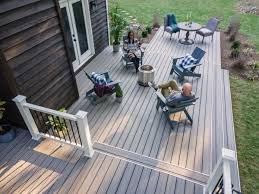
Understanding Composite Deck Costs
Composite decking has become a popular choice for homeowners looking to enhance their outdoor living spaces. With its blend of durability, low maintenance, and aesthetic appeal, composite decking offers many advantages over traditional wood. However, one of the most crucial aspects to consider when planning a deck project is the cost. In this article, we will explore various factors that influence composite deck costs and provide insights to help you budget effectively for your project.
What is Composite Decking?
Before delving into composite deck costs, it’s essential to understand what composite decking is. Composite decking is made from a mixture of wood fibers and recycled plastic materials. This combination results in a material that mimics the appearance of wood but requires less maintenance and offers greater resistance to the elements. Composite decking comes in a variety of colors, textures, and finishes, allowing homeowners to customize their decks to match their style and preferences.
Factors Influencing Composite Deck Costs
Several factors contribute to the overall cost of a composite deck. Here are some key considerations:
- Size of the Deck: The size of your deck is one of the most significant factors affecting composite deck costs. Larger decks require more materials, leading to higher expenses. It’s essential to measure your space accurately and plan the dimensions of your deck accordingly.
- Quality of Materials: Composite decking comes in different quality grades, ranging from basic to premium. Higher-quality materials often come with enhanced features such as better durability, a more realistic wood appearance, and longer warranties. While premium materials may come at a higher initial cost, they can offer better value over time due to their longevity and reduced maintenance needs.
- Design Complexity: The complexity of your deck design can also impact composite deck costs. Simple, straightforward designs with standard shapes and layouts tend to be more affordable. In contrast, intricate designs with multiple levels, custom shapes, built-in seating, or elaborate railing systems can increase the overall cost.
- Labor Costs: Labor is another significant component of composite deck costs. Hiring a professional contractor ensures that your deck is built to code and with high craftsmanship, but it comes at a price. Labor costs can vary based on the contractor’s experience, location, and the project’s complexity. It’s advisable to obtain multiple quotes from reputable contractors to find the best balance between quality and cost.
- Additional Features: Adding features such as lighting, stairs, built-in benches, or pergolas can enhance the functionality and aesthetics of your deck but will also increase the overall cost. Consider which features are essential for your needs and prioritize accordingly.
Breakdown of Composite Deck Costs
To give you a better understanding of how composite deck costs are calculated, let’s break down the expenses involved:
- Materials: The cost of composite decking materials typically ranges from $6 to $12 per square foot, depending on the quality and brand. Additional materials such as fasteners, screws, and railings should also be factored into the budget.
- Labor: Labor costs for installing a composite deck can vary widely but generally range from $8 to $15 per square foot. This includes site preparation, framing, decking installation, and finishing touches.
- Permits and Inspections: Depending on your location, you may need permits and inspections for your deck project. Permit fees can range from $50 to $500, and inspection fees may be required during and after construction.
- Additional Features: Costs for additional features such as lighting, built-in seating, and custom railings can add anywhere from a few hundred to several thousand dollars to your project. It’s essential to budget for these extras if you plan to include them in your deck design.
Cost Comparison: Composite Decking vs. Wood Decking
While composite deck costs are typically higher upfront compared to wood decking, it’s essential to consider the long-term value. Here’s a comparison of the two options:
- Initial Costs: Wood decking is generally less expensive than composite decking initially. Pressure-treated wood, for example, can cost as little as $2 to $5 per square foot. However, the overall cost of a wood deck can increase significantly due to ongoing maintenance requirements.
- Maintenance Costs: Composite decking requires minimal maintenance, primarily consisting of occasional cleaning with soap and water. Wood decking, on the other hand, requires regular staining, sealing, and potentially replacing damaged boards. These maintenance tasks can add substantial costs over the life of the deck.
- Lifespan: Composite decking typically has a longer lifespan than wood decking. While wood decks may need significant repairs or replacement after 10-15 years, composite decks can last 25-30 years or more with proper care.
- Environmental Impact: Composite decking is often made from recycled materials, making it a more environmentally friendly choice compared to wood decking, which involves cutting down trees and can contribute to deforestation.
Tips for Reducing Composite Deck Costs
If you’re looking to keep composite deck costs within your budget, consider the following tips:
- Plan and Prioritize: Carefully plan your deck design and prioritize essential features. Opt for a simpler design if you’re working with a limited budget.
- DIY Installation: If you have the skills and experience, consider installing the deck yourself. This can significantly reduce labor costs, though it’s essential to ensure that the installation meets building codes and safety standards.
- Shop Around: Obtain quotes from multiple suppliers and contractors to find competitive prices for materials and labor. Look for sales or discounts on composite decking materials.
- Choose Standard Colors and Sizes: Custom colors and sizes may come at a premium. Sticking to standard options can help reduce costs without sacrificing quality.
Conclusion
Understanding composite deck costs is essential for budgeting and planning your deck project effectively. While composite decking may have a higher initial cost compared to wood, its durability, low maintenance, and long-term value make it a worthwhile investment. By considering the factors that influence costs and exploring ways to save, you can create a beautiful and functional outdoor space that enhances your home and provides years of enjoyment.









